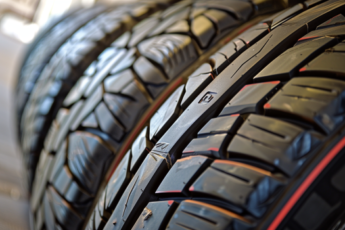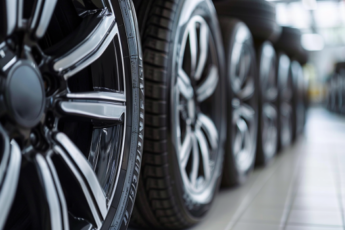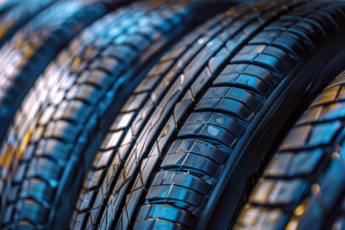Last Updated on 6 months
Essential Tire Maintenance for a Safe and Smooth Journey
When caring for your vehicle, there is nothing more important than Safety. These days, cars are designed with all types of safety features like cameras and sensors to protect the driver and other cars on the road. But tire maintenance is one crucial part of your vehicle’s Safety that is often overlooked.
You may be surprised to learn that bad tires cause more accidents on the road than drivers using cell phones. Tire issues like excess wear, poor inflation, or other damage can interfere with your vehicle’s handling and overall performance.
Keeping up with tire maintenance is incredibly beneficial – and not nearly as difficult or expensive as you think. But first, let’s discuss some of the key reasons you need to ensure your tires are properly maintained.
Benefits of Proper Tire Care
Proper tire care is like giving your vehicle the best shoes. As well-maintained shoes provide comfort and support, well-cared-for tires offer Safety and performance on the road. In this section, we’ll explore the benefits of tire maintenance and why it’s essential for your driving experience.
a. Safety
Poorly maintained tires have a longer stopping range and poorer traction, which can lead to losing control over the vehicle. The risk of an accident is even more significant in poor weather, as the tires cannot grip the road through rain, snow, or ice.
Proper tire maintenance ensures that tires are installed correctly for optimal handling and a safer ride.
b. Fuel Efficiency
Another incredible benefit to routine tire maintenance is improved fuel efficiency. You can increase your vehicle’s gas mileage average by up to 3% by keeping the tire pressure within the recommended range. While this may sound minimal, it can equate to quite a few dollars saved with fewer fill-ups!
Under-inflated tires require more fuel and energy to rotate, whereas inflated tires turn much more accessible.
c. Longer Tire Life
Just as you can extend the life and use of your vehicle with regular tune-ups, you can also extend the life of your tires if you take good care of them. Failing to follow everyday tire care – like rotations and inflation – can cause the rubber to wear down much faster.
d. Better for the Environment
Every year, millions of tires are thrown away and sit in landfills. The rubber on these tires is not always recyclable and takes decades to decompose. You can reduce the number of tires thrown away yearly by keeping up with tire maintenance.
e. Cost Savings
While you can undoubtedly buy great tires cheaply, taking proper care of them can mean you need to replace them less frequently. Good tires are not cheap; you want to maintain them as long as possible.
Keeping up with tire maintenance is beneficial for many reasons. But how can you take care of your tires and avoid these issues that could lead to expensive repairs and replacements?
Here are some tire maintenance tips to help you:
Tire maintenance tips are your road map to a safe and smooth journey. These simple guidelines can help you ensure that your tires are in top-notch condition, providing peace of mind and enhancing your overall driving experience. In this section, we’ll walk you through some easy-to-follow tips to keep your tires performing at their best.
1. Check Tire Pressure Routinely
Air will seep out of your tires over time, especially if you drive long distances or at high speeds. The lower the air pressure is, the greater the chances of a tire blowout. Low tire pressure also increases friction between the rubber and the road. This causes the tread to wear out much faster and can even make the tire overheat.
It is best to check your tire pressure every month, before and after long road trips. You can check this with a tire gauge from your mechanic or auto parts shop or take your car to a mechanic and ask them to check it.
To check on your own, unscrew the valve and push the gauge in until some air is released. This will measure the PSI or the pressure per square inch.
So, what is a good tire pressure? The recommended tire pressure range is typically between 30 to 35 PSI. Be sure to consult your vehicle owner’s manual for the recommended tire pressure and your tire to ensure the content is appropriate for the tire requirements.
2. Monitor the Tread Depth
A tire’s tread promotes a firm grip and traction on all surfaces, primarily through rain, mud, or gravel. Uneven wear or shallow tread can cause your vehicle to hydroplane or spin out, which is extremely dangerous.
A monthly tire tread inspection is essential to see if the depth is safe for driving. A handy way to check is to use a penny.
You will place a penny upside-down into the tread, with the Lincoln head facing towards you. If you can see the top of his head, the track is too worn, and your tires need replacing.
3. Don’t Skip Regular Tire Rotation
The tires on your vehicle do not wear out evenly due to uneven weight distribution. Front tires tend to wear out faster since this is where most of the weight is placed from mechanical parts and passengers. Tire rotation helps promote even wear so that all your tires can be replaced simultaneously.
It is generally recommended that your tires are rotated every 5,000 to 8,000 miles. If you’ve got some handy car skills, you can do this independently – but it is usually best to have your mechanic handle the job.
During a tire rotation, the back tires are placed on the front and vice versa. It is also best to switch the sides of the tires. For example, the right rear tire will go on the front left – so no side of the tire wears out faster than the other.
4. Consider the Weight
Too much weight in your vehicle can wear down your tires faster and lower fuel efficiency. Every 100 lbs of additional weight can reduce your vehicle’s fuel economy by 2% and add unnecessary friction to your tires.
So, part of your routine tire maintenance should include cleaning out the extra junk from your car. Ensure you only keep items you use or need in an emergency. Any additional items should be kept inside the garage.
5. Keep Good Alignment
The alignment of your tires can fall out of balance when you go over bumps in the road. This will change the angle at which your wheels and tires point to meet the road, which will wear down tires faster and irregularly. Uneven alignment can also result in a bouncier, less comfortable ride from your vehicle.
One easy way to test for alignment issues is to drive on a straight road. Set your steering wheel straight ahead and carefully release your grip slightly. If your vehicle starts to veer towards one side naturally, it’s a sign that the alignment is off. Other signals of alignment issues include feeling vibrations when you accelerate or turn and difficulty handling while driving.
You should bring your vehicle in for a professional alignment test and repair to resolve the issue.
6. Keep a Spare
Even if you have a set of brand-new tires, it is always recommended that you keep a spare handy. Checking on the status of this spare should be a part of your tire maintenance routine – since it’s easy to forget about until a case of emergency!
Additionally, you should ensure it’s at a proper tire pressure to be used immediately if you get a flat. Make sure that it is safely stored as well. Rubber can crack and dry out if exposed to high heat or direct sun for too long. The rubber can also get scratched or punctured. Investing in a well-fitting tire cover is best if your spare is mounted on the back of your vehicle.
Conclusion
Keeping up with consistent tire maintenance can tremendously extend your tire life. But the best way to get the most bang for your buck is by purchasing top-quality tires in the first place. Good quality tire models will provide better handling and fuel economy and will not wear out as fast as poorly made models.
Your Safety on the road begins with well-maintained tires. In this guide, we’ve shared six essential tire maintenance tips to help you stay safe and enjoy a smooth journey. Remember, regular tire maintenance is not just a task; it’s a responsibility that ensures your Safety and the Safety of others on the road.
Ready to invest in quality tires and maintain them for a safe journey?
Visit Giga Tires today to explore our range of quality tires and tire maintenance tools. Your path to safer and more enjoyable road trips starts here!
At Giga Tires, we pride ourselves on offering only the best of the best when it comes to tires. We carry various tire styles, brand names, and sizes to fit any vehicle and budget. Please reach out to us to learn more and place an order today!
Take a deeper dive into tire know-how! Explore our website, Giga Tires, for a wealth of articles that will keep you informed.
- Best Trailer Tires: Choosing The Top 5 Radial And Bias Trailer Tires
- Exploring The Best 2 Iris Tires: Unveiling Quality And Performance
- Winter Tires Wisdom: 21 FAQs To Ensure Safe And Powerful Cold-Weather Driving
FAQs
What is the recommended way to maintain safe tires?
The recommended way to maintain safe tires is to regularly check and maintain proper tire pressure, inspect your tires for damage, ensure proper wheel alignment, rotate your tires at the recommended intervals, and keep an eye on tread wear. These practices help ensure your tires are in good condition and provide optimal Safety on the road.
What is the most important aspect of tire maintenance and Safety?
Proper tire pressure is the most crucial aspect of tire maintenance and Safety. Underinflated tires can reduce traction and handling issues, increase braking distances, and damage. Maintaining the correct tire pressure is fundamental for safe and efficient driving.
What is the most critical task in tire maintenance?
Regularly checking and maintaining the proper tire pressure is the most crucial task in tire maintenance. It’s a simple yet critical practice that ensures your tires function optimally and can significantly contribute to your Safety on the road.
What is tire safety?
Tire safety encompasses all the practices and measures to ensure your vehicle’s tires are in good condition and perform effectively. This includes proper tire pressure, tread depth, visual inspections for damage, regular maintenance, and alignment checks. Tire safety is crucial for safe driving and reducing the risk of accidents on the road.











